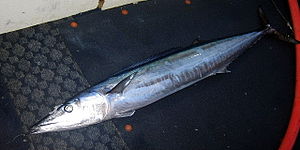Wahoo
| Wahoo | ||||||||||||
|---|---|---|---|---|---|---|---|---|---|---|---|---|

Wahoo ( Acanthocybium solandri ) |
||||||||||||
| Systematics | ||||||||||||
|
||||||||||||
| Scientific name of the genus | ||||||||||||
| Acanthocybium | ||||||||||||
| Gill , 1862 | ||||||||||||
| Scientific name of the species | ||||||||||||
| Acanthocybium solandri | ||||||||||||
| ( Cuvier , 1831) |
The wahoo ( Acanthocybium solandri ) is a large predatory fish from the mackerel and tuna family (Scombridae). It feeds on other fish and cephalopods .
Appearance
The wahoo resembles a barracuda with its slender, torpedo-shaped shape . The rafts between the last dorsal or anal fin and the caudal fin clearly show its relationship to the tuna . The Wahoo reaches an average body length of 100 cm to 170 cm, the maximum length is approx. 210 cm, with a weight of approx. 83 kg. The body is only slightly flattened on the sides and covered with small scales. The mouth is large and as long as the rest of the head. It is studded with strong, triangular, finely serrated teeth, which are arranged in a single row. The back of the upper jaw is completely covered by the pre-orbital bone (bone in front of the eye socket). Gill trap rays are absent. The Wahoo has two dorsal fins, the first and longer is supported by 23 to 27 hard rays, the second and shorter by 12 to 16 soft rays. Behind it there are 8 to 9 rafts. The short anal fin, which is symmetrical to the second dorsal fin, has 12 to 14 fin rays , followed by 9 flippers. The caudal fin stalk is narrow, the caudal fin itself is sickle-shaped. The single side line first runs close to the back line and then turns abruptly to the middle of the side of the body under the middle of the first dorsal fin. A swim bladder is available. The corset, which is typical for many tuna-like fish, consists of large, thick scales of armor behind the head and around the pectoral fins. The Wahoo has 62 to 64 vertebrae, 30 to 32 in front of the anus and 31 to 33 caudal vertebrae. The back of the Wahoo is blackish and iridescent blue-green, the sides of the body are silvery with 24 to 30 cobalt blue, narrow, vertical stripes that extend over the sideline. Some are double or Y-shaped. The horizontal stripes turn black after the animals die.
distribution
The Wahoo lives in loose groups in tropical and subtropical areas of the Atlantic (including the Caribbean and Mediterranean ), e.g. B. off La Palma and the Indo-Pacific also far from the coasts on the high seas. It has many local names within its wide area, such as:
- Peto ( Latin America ), Canary Islands
- Ono ( Hawaii )
- Tangigue ( Philippines )
nutrition
It feeds on fish and cephalopods. Detected prey fish include herrings , flying fish , lantern fish , small jackfish and porcupine fish .
speed
The wahoo is one of the fastest fish in the world. When hunting, it reaches speeds of up to 80 km / h.
literature
- Bruce B. Collette, Cornelia E. Nauen: Scombrids of the world. An annotated and illustrated catalog of tunas, mackerels, bonitos and related species known to date (= FAO Species Catalog. Vol. 2 = FAO Fisheries Synopsis. No. 125, Vol. 2). United Nations Development Program et al., Rome 1983, ISBN 92-5-101381-0 , ( complete edition ).
Web links
- Wahoo on Fishbase.org (English)
- Acanthocybium solandri inthe IUCN Red List of Threatened Species 2013.1. Posted by: Collette, B., Acero, A., Amorim, AF, Boustany, A., Canales Ramirez, C., Cardenas, G., Carpenter, KE, de Oliveira Leite Jr., N., Di Natale, A ., Die, D., Fox, W., Fredou, FL, Graves, J., Guzman-Mora, A., Viera Hazin, FH, Hinton, M., Juan Jorda, M., Kada, O., Minte Vera, C., Miyabe, N., Montano Cruz, R., Nelson, R., Oxenford, H., Restrepo, V., Salas, E., Schaefer, K., Schratwieser, J., Serra, R. , Sun, C., Teixeira Lessa, RP, Pires Ferreira Travassos, PE, Uozumi, Y. & Yanez, E., 210. Retrieved September 10, 2013.